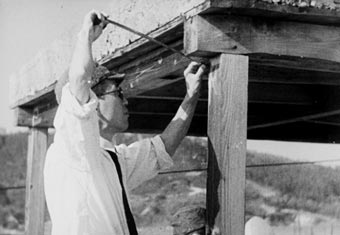
[22] |
[22]
Estimation of burst height from shadows
September 29, 1945 Enkobashi-cho Hiroshima City Credit Union Enkobashi branch office 1,920m from the hypocenter Taken by Japan Film Corporation (Kiyoji Suzuki)
The hypocenter and burst height were estimated based on the shadows formed by the shielded heat rays. In the photograph, investigator Eizo Tajima is calculating the burst height by measuring the shadow left at an air defense observation post on the roof of the Hiroshima City Credit Union's Enkobashi branch office. |
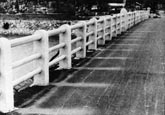
[23]
Shadow of parapet left on bridge
October 1945 Yorozuyo Bridge
890m from the hypocenter Taken by Japan Film Corporation (Kimio Matano)
On Yorozuyo Bridge, which was exposed to heat rays from the left side of the photograph, shadow-like images were left on the surfaces that had been shielded by the parapet. |
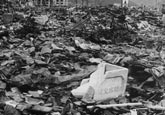
[24]
Rubble-scattered streets
October 20, 1945
Taken by Japan Film Corporation (Kimio Matano)
In order to understand the features of the damage caused by the heat rays, Hidetsugu Aihara, who was in charge of the physics team's production, walked through the charred rubble and examined objects such as scattered roof tiles and stones. Roof tiles that had been exposed to the heat rays were melted and foam-like on the surface. |

[25]
Gathering materials for radiation survey
September 24, 1945 Sarugaku-cho (now, Ote-machi 1-chome)
150m from the hypocenter Taken by Japan Film Corporation (Kiyoji Suzuki)
Appearing in the image is Motoharu Kimura who is gathering objects such as bones and insulators for the radiation survey. Even a month and a half after the bombing, human bones remained in this area. |
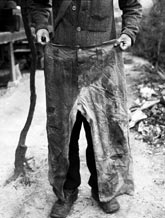
[26]
Pair of pants exposed to black rain
October 1945 Koi-machi (now, Koi-ue)
3,700m from the hypocenter Photo by Shigeo Hayashi
The filming staff filmed the devastation of the bomb over a wide range of the city. Staff members visited the western part of the city and filmed materials that had been exposed to black rain, and they collected samples of mud that had adhered to house shutters. |
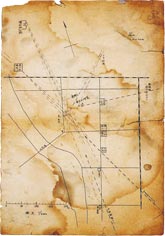
[27] |
[27]
Map used to find hypocenter
Donated by Peace Museum of Saitama (from "Material provided by Hidetsugu Aihara")
The "shadows" created by the heat rays were measured, their directions were drawn as lines on the map, and the intersecting point of the lines was regarded as the hypocenter. Objects such as the Hiroshima Gokoku Shrine's stone lanterns and guardian dogs served as materials for estimating the hypocenter. |






